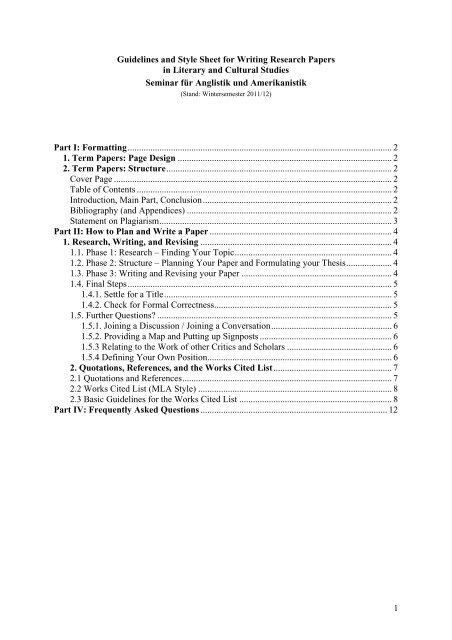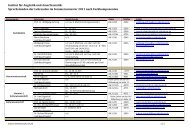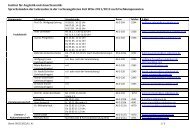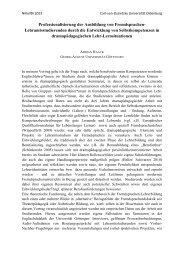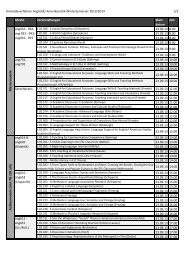1 Guidelines and Style Sheet for Writing Research Papers in Literary ...
1 Guidelines and Style Sheet for Writing Research Papers in Literary ...
1 Guidelines and Style Sheet for Writing Research Papers in Literary ...
You also want an ePaper? Increase the reach of your titles
YUMPU automatically turns print PDFs into web optimized ePapers that Google loves.
<strong>Guidel<strong>in</strong>es</strong> <strong>and</strong> <strong>Style</strong> <strong>Sheet</strong> <strong>for</strong> <strong>Writ<strong>in</strong>g</strong> <strong>Research</strong> <strong>Papers</strong><br />
<strong>in</strong> <strong>Literary</strong> <strong>and</strong> Cultural Studies<br />
Sem<strong>in</strong>ar für Anglistik und Amerikanistik<br />
(St<strong>and</strong>: W<strong>in</strong>tersemester 2011/12)<br />
Part I: Formatt<strong>in</strong>g .................................................................................................................... 2<br />
1. Term <strong>Papers</strong>: Page Design .............................................................................................. 2<br />
2. Term <strong>Papers</strong>: Structure ................................................................................................... 2<br />
Cover Page .......................................................................................................................... 2<br />
Table of Contents ................................................................................................................ 2<br />
Introduction, Ma<strong>in</strong> Part, Conclusion ................................................................................... 2<br />
Bibliography (<strong>and</strong> Appendices) .......................................................................................... 2<br />
Statement on Plagiarism ...................................................................................................... 3<br />
Part II: How to Plan <strong>and</strong> Write a Paper ................................................................................ 4<br />
1. <strong>Research</strong>, <strong>Writ<strong>in</strong>g</strong>, <strong>and</strong> Revis<strong>in</strong>g .................................................................................... 4<br />
1.1. Phase 1: <strong>Research</strong> – F<strong>in</strong>d<strong>in</strong>g Your Topic ..................................................................... 4<br />
1.2. Phase 2: Structure – Plann<strong>in</strong>g Your Paper <strong>and</strong> Formulat<strong>in</strong>g your Thesis .................... 4<br />
1.3. Phase 3: <strong>Writ<strong>in</strong>g</strong> <strong>and</strong> Revis<strong>in</strong>g your Paper .................................................................. 4<br />
1.4. F<strong>in</strong>al Steps .................................................................................................................... 5<br />
1.4.1. Settle <strong>for</strong> a Title .................................................................................................... 5<br />
1.4.2. Check <strong>for</strong> Formal Correctness .............................................................................. 5<br />
1.5. Further Questions? ....................................................................................................... 5<br />
1.5.1. Jo<strong>in</strong><strong>in</strong>g a Discussion / Jo<strong>in</strong><strong>in</strong>g a Conversation ..................................................... 6<br />
1.5.2. Provid<strong>in</strong>g a Map <strong>and</strong> Putt<strong>in</strong>g up Signposts .......................................................... 6<br />
1.5.3 Relat<strong>in</strong>g to the Work of other Critics <strong>and</strong> Scholars .............................................. 6<br />
1.5.4 Def<strong>in</strong><strong>in</strong>g Your Own Position ................................................................................. 6<br />
2. Quotations, References, <strong>and</strong> the Works Cited List .................................................... 7<br />
2.1 Quotations <strong>and</strong> References ............................................................................................ 7<br />
2.2 Works Cited List (MLA <strong>Style</strong>) ..................................................................................... 8<br />
2.3 Basic <strong>Guidel<strong>in</strong>es</strong> <strong>for</strong> the Works Cited List ................................................................... 8<br />
Part IV: Frequently Asked Questions .................................................................................. 12<br />
1
Part I: Formatt<strong>in</strong>g<br />
1. Term <strong>Papers</strong>: Page Design<br />
o Layout: DIN A4, pr<strong>in</strong>t on one side of the paper only, right marg<strong>in</strong>: 3 cm, left marg<strong>in</strong>:<br />
4cm, top <strong>and</strong> bottom marg<strong>in</strong>s: 2,5 cm<br />
o Text: use Times New Roman font, type size 12pt, 1.5 l<strong>in</strong>e spac<strong>in</strong>g, justification, mark<br />
each paragraph – except those follow<strong>in</strong>g immediately after a headl<strong>in</strong>e or sub-headl<strong>in</strong>e –by<br />
<strong>in</strong>dentation of the first l<strong>in</strong>e (one tab stop)<br />
o Quotations: Short quotations (up to three l<strong>in</strong>es) are <strong>in</strong>corporated <strong>in</strong>to the ma<strong>in</strong> text<br />
“between double quotes” (double quotes with<strong>in</strong> the quotations become s<strong>in</strong>gle ‘<strong>in</strong>verted<br />
commas’). Longer quotations are set off <strong>in</strong> one block, without quotation marks, left <strong>in</strong>dent<br />
by 1.25 cm, s<strong>in</strong>gle-spaced, type size 11pt, blank l<strong>in</strong>e be<strong>for</strong>e <strong>and</strong> after<br />
o Footnotes: same font type; 10pt, s<strong>in</strong>gle spac<strong>in</strong>g, justification, no <strong>in</strong>dentations, end each<br />
footnote with a full stop<br />
o Bibliography: use Times New Roman font, type size 12pt; s<strong>in</strong>gle spac<strong>in</strong>g; hang<strong>in</strong>g <strong>in</strong>dent<br />
by 1.25 cm<br />
o Head<strong>in</strong>gs: use same font <strong>and</strong> same font size, no colours, Arabic numbers only; capitalize<br />
all words except function words (such as <strong>and</strong>, or, the, a, …)<br />
o Pag<strong>in</strong>ation: same font; same font size; starts with the title page but is not made visible as<br />
a page number until the first page of the text<br />
o Do not use a folder or other wrapp<strong>in</strong>g materials. H<strong>and</strong> <strong>in</strong> your paper on time, stapled<br />
together <strong>in</strong> the top left h<strong>and</strong> corner <strong>and</strong> hole-punched<br />
2. Term <strong>Papers</strong>: Structure<br />
Cover Page<br />
(university), (<strong>in</strong>stitute, department), (summer or w<strong>in</strong>ter semester, year), (course module,<br />
course type, course title), (type of paper: term paper/ portfolio/ Ausarbeitung etc.), (expected<br />
number of credit po<strong>in</strong>ts), (name of <strong>in</strong>structor), (date of h<strong>and</strong><strong>in</strong>g <strong>in</strong>), (title <strong>and</strong> subtitle of term<br />
paper), (your name), (matriculation number), (address, telephone number, e-mail), (subjects:<br />
majors <strong>and</strong> m<strong>in</strong>ors), (course of study, e.g. M.Ed.Gym), (semester)<br />
Table of Contents<br />
Always give page numbers; make sure page numbers are <strong>in</strong> one vertical l<strong>in</strong>e, right-aligned;<br />
capitalize titles <strong>and</strong> subtitles (exception: function words); do not give chapter numbers <strong>for</strong><br />
bibliography, appendix etc.; make sure your table of contents shows the exact same head<strong>in</strong>gs<br />
as your paper.<br />
Introduction, Ma<strong>in</strong> Part, Conclusion<br />
Bibliography (<strong>and</strong> Appendices)<br />
Same font, same font size; same marg<strong>in</strong>s; left aligned, s<strong>in</strong>gle space; alphabetical order by the<br />
last name of the (first) author; each entry with hang<strong>in</strong>g <strong>in</strong>dent by 1.25 cm.<br />
2
Statement on Plagiarism<br />
Every paper, essay, or assignment you h<strong>and</strong> is expected to present your own work <strong>and</strong> not that<br />
of others. So when mak<strong>in</strong>g use of other people’s thoughts <strong>and</strong> ideas <strong>in</strong> your paper, you always<br />
have to name the particular source from which you got these pieces <strong>in</strong><strong>for</strong>mation – no matter<br />
whether they are from an article, a book, an <strong>in</strong>terview, the <strong>in</strong>ternet or from any other source<br />
available.<br />
If you do not properly document your sources <strong>and</strong> thus pass off other people’s thoughts<br />
<strong>and</strong> ideas as your own, you plagiarize. It does not matter whether you copy the orig<strong>in</strong>al text<br />
word <strong>for</strong> word, slightly modify it, ‘skip-quote’ it (i.e. take bits <strong>and</strong> pieces from the orig<strong>in</strong>al<br />
text <strong>and</strong> arrange them <strong>in</strong> a new order), or just paraphrase the general l<strong>in</strong>e of argument of the<br />
orig<strong>in</strong>al text – all these cases are considered plagiarism.<br />
If you do plagiarize, you will not get any credit <strong>for</strong> your paper. All cases of plagiarism will<br />
be reported to the “Prüfungsamt”. Please note that plagiarism may result <strong>in</strong> expulsion from<br />
university.<br />
To acknowledge that you are familiar with the university’s policies on plagiarism, please copy<br />
<strong>and</strong> paste the follow<strong>in</strong>g paragraph, add date <strong>and</strong> signature, <strong>and</strong> <strong>in</strong>clude it on a separate sheet at<br />
the end of your paper:<br />
Hiermit erkläre ich, dass ich die Arbeit selbständig verfasst bzw. gestaltet und ke<strong>in</strong>e <strong>and</strong>eren<br />
als die angegebenen Quellen und Hilfsmittel benutzt und die allgeme<strong>in</strong>en Pr<strong>in</strong>zipen<br />
wissenschaftlicher Arbeit und Veröffentlichungen, wie sie <strong>in</strong> den Leitl<strong>in</strong>ien guter<br />
wissenschaftlicher Praxis der Carl von Ossietzky Universität Oldenburg festgelegt s<strong>in</strong>d,<br />
befolgt habe.<br />
(Vgl. §11 Abs. 15 der Prüfungsordnung für die Fach-Bachelor- und Zwei-Fächer-<br />
Bachelorstudiengänge (BPO), Allg. Teil, Fassung von 2010.)<br />
(Vgl. §12 Abs. 20 der jeweiligen Prüfungsordnungen für die Studiengänge Master of<br />
Education (Grund- und Hauptschule) (MPO – GH), Allg. Teil, Fassung von 2008; Master of<br />
Education (Gymnasium) (MPO – Gym), Allg. Teil, Fassung von 2008; Master of Education<br />
(Realschule) (MPO – R), Allg. Teil, Fassung von 2008; Master of Education<br />
(Sonderpädagogik) (MPO – SoPäd), Allg. Teil, Fassung von 2008; und Master of Education<br />
(Wirtschaftspädagogik) (MPO – WiPäd), Allg. Teil, Fassung von 2008.)<br />
Bewertungskriterien für wissenschaftliche Arbeiten<br />
Also pr<strong>in</strong>t out <strong>and</strong> fill <strong>in</strong> the feedback sheet (Bewertungskriterien für literatur- und<br />
kulturwissenschaftliche Hausarbeiten und Abschlussarbeiten <strong>in</strong> der Anglistik/Amerikanistik) <strong>and</strong> h<strong>and</strong><br />
it <strong>in</strong> together with your paper. Do not <strong>in</strong>clude this sheet <strong>in</strong> your paper, but h<strong>and</strong> it <strong>in</strong> separately.<br />
3
Part II: How to Plan <strong>and</strong> Write a Paper<br />
1. <strong>Research</strong>, <strong>Writ<strong>in</strong>g</strong>, <strong>and</strong> Revis<strong>in</strong>g<br />
The process of writ<strong>in</strong>g research papers can be divided <strong>in</strong> three phases:<br />
1.1. Phase 1: <strong>Research</strong> – F<strong>in</strong>d<strong>in</strong>g Your Topic<br />
o Start from an observation or a question that you found remarkable <strong>in</strong> some manner. (Try<br />
to grasp what it is that strikes you about this phenomenon.)<br />
o Check the state of research: Has this been asked or observed be<strong>for</strong>e (long ago, only<br />
recently)? Do critics agree or are there controversies? For this purpose, you need to use<br />
bibliographic tools (such as the MLA bibliography), <strong>and</strong> to read <strong>and</strong> excerpt the materials<br />
that make reference to your topic.<br />
o Return to the primary material you plan to analyse, pick<strong>in</strong>g out passages <strong>and</strong> aspects that<br />
are particularly relevant to your topic.<br />
1.2. Phase 2: Structure – Plann<strong>in</strong>g Your Paper <strong>and</strong> Formulat<strong>in</strong>g your Thesis<br />
Once you have looked at the state of research <strong>and</strong> exam<strong>in</strong>ed your materials, review the<br />
results: How do the various results of your research fit together? Are they sufficient to<br />
account <strong>for</strong> your <strong>in</strong>itial question <strong>in</strong> a satisfactory way? If so, good. If not, even better. In either<br />
case, you can now go about present<strong>in</strong>g your evidence <strong>and</strong> your evaluation of it to an academic<br />
audience.<br />
o Def<strong>in</strong>e your goal (i.e. <strong>for</strong>mulate your research problem <strong>and</strong> your thesis): Make up your<br />
m<strong>in</strong>d about what precisely you want to demonstrate concern<strong>in</strong>g the topic you have chosen.<br />
Try to state this as completely, precisely <strong>and</strong> concisely as possible. (This usually takes<br />
several attempts, <strong>and</strong> is done parallel to the two follow<strong>in</strong>g steps.)<br />
o Choose a structure that leads to your goal: Arrange the results of your research (both<br />
primary <strong>and</strong> secondary materials) <strong>in</strong> such a way that all the relevant materials, <strong>in</strong><strong>for</strong>mation<br />
<strong>and</strong> arguments are presented <strong>in</strong> such an order that they lead to the goal that you have set<br />
yourself. In order to reach a particular result, it is usually necessary to take several steps of<br />
analysis <strong>and</strong> reflection.<br />
o Make the structure of your argument explicit: The structure of your outl<strong>in</strong>e (i.e. the<br />
head<strong>in</strong>gs <strong>in</strong> the table of contents) should match the l<strong>in</strong>e of argument you have chosen, <strong>and</strong><br />
should provide the reader with a ‘map’ of the steps of analysis <strong>and</strong> reflection that he or she<br />
is <strong>in</strong>vited to take.<br />
1.3. Phase 3: <strong>Writ<strong>in</strong>g</strong> <strong>and</strong> Revis<strong>in</strong>g your Paper<br />
Once you have arranged the results of your research <strong>in</strong> such a way that they lead towards<br />
demonstrat<strong>in</strong>g the proposition you have <strong>for</strong>mulated, you are ready to start writ<strong>in</strong>g.<br />
Term papers usually are written <strong>in</strong> this order:<br />
o The <strong>in</strong>troduction: state what you are go<strong>in</strong>g to exam<strong>in</strong>e <strong>and</strong> what you are hop<strong>in</strong>g to show,<br />
how you are go<strong>in</strong>g to proceed (between which alternative methods did you choose) <strong>and</strong><br />
give reasons <strong>for</strong> both (why is the topic relevant to an academic debate? why do you<br />
choose to treat the topic <strong>in</strong> the way you have chosen?).<br />
NOTE: In your response to the questions what?, how? <strong>and</strong> why? take <strong>in</strong>to account the<br />
current state of research (which you have established <strong>in</strong> phase 1 <strong>and</strong> 2). If an extensive<br />
4
eport on research should be necessary, you may give this an extra chapter head<strong>in</strong>g after<br />
the <strong>in</strong>troduction.<br />
o The chapters that make up your ma<strong>in</strong> part (i.e. the head<strong>in</strong>gs <strong>in</strong> the table of contents)<br />
should match the l<strong>in</strong>e of argument you have chosen, <strong>and</strong> should provide the reader with a<br />
‘map’ of the steps of analysis <strong>and</strong> reflection that he or she is <strong>in</strong>vited to take.<br />
o The conclusion does not <strong>in</strong>troduce any new analytical steps. You should summarise at a<br />
higher level of abstraction the results of the analytical steps you have taken. Then address<br />
the question of what follows from your analysis. What questions rema<strong>in</strong> unsolved? What<br />
new questions have become visible <strong>in</strong> the course of your analysis? What direction could<br />
the debate take at this juncture?<br />
o Revision. Hav<strong>in</strong>g written a first draft of your text, check your text <strong>and</strong> your argument <strong>for</strong><br />
cohesion, <strong>and</strong> especially revise the <strong>in</strong>troduction, if necessary. You may f<strong>in</strong>d it helpful to<br />
use the „feedback sheet“ <strong>in</strong> order to check whether your paper addresses the major criteria<br />
that your supervisors or referees will apply <strong>in</strong> assess<strong>in</strong>g your paper.<br />
1.4. F<strong>in</strong>al Steps<br />
1.4.1. Settle <strong>for</strong> a Title<br />
If you have not decided on your title be<strong>for</strong>e, this is the time to do it. Most titles consist of two<br />
parts. The ma<strong>in</strong> title usually <strong>in</strong>dicates the material(s) <strong>and</strong> topic(s) dealt with. The subtitle then<br />
<strong>in</strong>dicates the special perspective you wish to establish on the material(s) <strong>and</strong> topic(s). It is also<br />
possible to choose a ma<strong>in</strong> title that po<strong>in</strong>tedly h<strong>in</strong>ts at your thesis <strong>and</strong> a subtitle that <strong>in</strong>dicates<br />
the material(s) <strong>and</strong> topic(s) dealt with.<br />
Examples<br />
- ma<strong>in</strong> title: America on Film, subtitle: Represent<strong>in</strong>g Race, Class, Gender, <strong>and</strong> Sexuality at<br />
the Movies<br />
- ma<strong>in</strong> title: Child/Lov<strong>in</strong>g, subtitle: The Erotic Child <strong>and</strong> Victorian Culture<br />
1.4.2. Check <strong>for</strong> Formal Correctness<br />
Reread <strong>for</strong> typ<strong>in</strong>g errors, spell<strong>in</strong>g, grammar <strong>and</strong> syntax, <strong>in</strong>complete sentences, style,<br />
<strong>for</strong>matt<strong>in</strong>g specifications.<br />
Make sure the chapter head<strong>in</strong>gs <strong>in</strong> the table of contents <strong>and</strong> the head<strong>in</strong>gs used <strong>in</strong> the paper are<br />
the same.<br />
Make sure that all the sources you are quot<strong>in</strong>g are listed <strong>in</strong> the bibliography, <strong>and</strong> that the<br />
bibliography does not conta<strong>in</strong> any entries that are not referred to <strong>in</strong> the paper.<br />
Make sure that you have documented all sources <strong>for</strong> ideas or statements that you take over<br />
from other sources (avoid the appearance of plagiarism).<br />
1.5. Further Questions?<br />
Here are some further considerations about aspects of the research, structur<strong>in</strong>g <strong>and</strong> writ<strong>in</strong>g<br />
process. If you feel you could do with further guidance, you may try th<strong>in</strong>k<strong>in</strong>g about these<br />
po<strong>in</strong>ts.<br />
5
1.5.1. Jo<strong>in</strong><strong>in</strong>g a Discussion / Jo<strong>in</strong><strong>in</strong>g a Conversation<br />
Be<strong>for</strong>e you start <strong>and</strong> while you are writ<strong>in</strong>g you may f<strong>in</strong>d it helpful to th<strong>in</strong>k of your paper as a<br />
contribution to a conversation or a discussion. Be<strong>for</strong>e you make a contribution to a<br />
conversation, you will want to be aware of the issues that have been talked about <strong>and</strong> of the<br />
th<strong>in</strong>gs that have been said be<strong>for</strong>e.<br />
o You will not generally make statements simply ‘because they are true’ (even if they are<br />
true). If you refer to someth<strong>in</strong>g that has been said be<strong>for</strong>e, you will tend to <strong>in</strong>dicate<br />
somehow that you are aware of this.<br />
o Neither will you just say once more what someone has just said be<strong>for</strong>e you. If you<br />
<strong>in</strong>troduce <strong>in</strong><strong>for</strong>mation, you will tend to make clear why you are mention<strong>in</strong>g this.<br />
o In any case, you will generally check that your contribution is relevant to this<br />
conversation. You will also make clear what your own position is <strong>in</strong> the conversation: Is<br />
your purpose to agree with previous speakers <strong>and</strong> support what they have said? Is it to<br />
contradict them? Is it to add a different angle or to start a new topic?<br />
There are differences, of course: In everyday conversations you will check the relevance of<br />
your contribution more or less <strong>in</strong>tuitively. In written academic work, this process must be<br />
made explicit as part of your contribution <strong>and</strong> it usually takes a good deal longer.<br />
As you are do<strong>in</strong>g your research <strong>and</strong> f<strong>in</strong>d<strong>in</strong>g your topic, structur<strong>in</strong>g your ideas <strong>and</strong> your<br />
argument, <strong>and</strong> f<strong>in</strong>ally writ<strong>in</strong>g <strong>and</strong> revis<strong>in</strong>g your paper, it may help you to bear this <strong>in</strong> m<strong>in</strong>d.<br />
1.5.2. Provid<strong>in</strong>g a Map <strong>and</strong> Putt<strong>in</strong>g up Signposts<br />
As you are writ<strong>in</strong>g, make sure you signpost your paper: Where will you be tak<strong>in</strong>g the reader,<br />
by what means <strong>and</strong> by what route are you go<strong>in</strong>g to do this, <strong>and</strong> why should a reader want to<br />
go there with you? Make sure that you have addressed these questions <strong>in</strong> your <strong>in</strong>troduction.<br />
Give your readers a map, <strong>and</strong> set up signposts at appropriate places (e.g. at the beg<strong>in</strong>n<strong>in</strong>g <strong>and</strong><br />
/ or end of chapters) <strong>in</strong> order to prevent them from gett<strong>in</strong>g lost, <strong>and</strong> make sure that at the end<br />
they know where you have taken them <strong>and</strong> why they should want to be there.<br />
1.5.3 Relat<strong>in</strong>g to the Work of other Critics <strong>and</strong> Scholars<br />
o If other scholars have already dealt with this topic, ask: Do they agree with each other? Is<br />
there a current controversy? Were there controversies <strong>in</strong> the past? What were the po<strong>in</strong>ts<br />
that were debated, what arguments were used (what k<strong>in</strong>d of references were made to the<br />
primary materials you have analysed)? Was there a shift <strong>in</strong> op<strong>in</strong>ion?<br />
o If few or no other scholars have dealt with this topic (made this observation, raised this<br />
question): why have they overlooked it? Is it simply too obvious, too easy to answer?<br />
Have they focused on someth<strong>in</strong>g else <strong>in</strong>stead (on what, <strong>and</strong> why)? What has prevented<br />
them from mak<strong>in</strong>g this observation (or rais<strong>in</strong>g this question)? What would be ga<strong>in</strong>ed by<br />
rais<strong>in</strong>g this question? Were they right or wrong to ignore this question (Perhaps it is too<br />
obvious or trivial? Perhaps they were prevented from perceiv<strong>in</strong>g its relevance by some<br />
k<strong>in</strong>d of unjustified bias?)<br />
1.5.4 Def<strong>in</strong><strong>in</strong>g Your Own Position<br />
Your l<strong>in</strong>e of argument will depend on where you st<strong>and</strong> <strong>in</strong> relation to this state of research. Is<br />
your goal to compare <strong>and</strong> evaluate critically the (different) exist<strong>in</strong>g research positions <strong>and</strong><br />
measure them by the degree of <strong>in</strong>sight <strong>and</strong> relevance they have <strong>for</strong> the question that you have<br />
chosen? Is your goal to add new perspective to the research?<br />
6
Once you have looked at the state of research <strong>and</strong> the primary material as it relates to the topic<br />
that <strong>in</strong>terests you, you can <strong>for</strong>mulate a proposition that you will seek to substantiate. Here are<br />
a few typical l<strong>in</strong>es of argument that may help you decide which argument should guide your<br />
structure:<br />
o One typical l<strong>in</strong>e of argument: Scholars have always agreed that this phenomenon should<br />
be described as [x], but I disagree. The reasons [if any] they have given, are the<br />
follow<strong>in</strong>g… The reasons why I disagree are the follow<strong>in</strong>g.<br />
o Another typical l<strong>in</strong>e of argument: Scholars have never been able to agree about whether<br />
we should describe this phenomenon as [a] or as [b]. Those who favour [a] argue that …,<br />
those who favour [b] argue that …, a critical evaluation of their arguments shows that …<br />
[a is right / b is right / both are partly right <strong>and</strong> partly wrong / both are wrong <strong>and</strong> c is<br />
right]…<br />
o A third typical l<strong>in</strong>e of argument: Scholars have never noticed [a]. They have been talk<strong>in</strong>g<br />
about [b] <strong>and</strong> [c], however. In my judgment, the follow<strong>in</strong>g reason(s) may be responsible<br />
<strong>for</strong> the fact that they have done so. I will now try to show why they were right [wrong] to<br />
ignore [a], <strong>for</strong> the follow<strong>in</strong>g reasons…<br />
o …<br />
2. Quotations, References, <strong>and</strong> the Works Cited List<br />
2.1 Quotations <strong>and</strong> References<br />
When work<strong>in</strong>g with primary <strong>and</strong> secondary sources, you can either quote directly from the<br />
respective material or summarize / paraphrase important aspects <strong>in</strong> your own words.<br />
If you quote directly, you have to give the author of the text you refer to <strong>and</strong> the page(s) on<br />
which your quote can be found. If you have two or more works by the same author, also give<br />
an abbreviated <strong>for</strong>m of the title to <strong>in</strong>dicate which particular work you are referr<strong>in</strong>g to. This<br />
<strong>in</strong><strong>for</strong>mation is given <strong>in</strong> round brackets immediately after the respective quotation.<br />
NOTE: When omitt<strong>in</strong>g parts of the orig<strong>in</strong>al text <strong>in</strong> your quotation, use “[…]” to <strong>in</strong>dicate<br />
where someth<strong>in</strong>g has been left out.<br />
Examples:<br />
“…[…]…” (Fenton 45); “…” (Hall “Deconstruct<strong>in</strong>g” 230-31); “…” (Roth Portnoy 25)<br />
If you summarize or paraphrase other peoples’ works, you also have to give the author, a<br />
short title (if necessary) <strong>and</strong> the page number(s). To <strong>in</strong>dicate that you are paraphras<strong>in</strong>g <strong>and</strong> not<br />
quot<strong>in</strong>g directly, add the abbreviation “cf.” (i.e. “confer”).<br />
Examples:<br />
… (cf. Fenton 45); … (cf. Hall “Deconstruct<strong>in</strong>g” 230-31); … (cf. Roth Portnoy 25)<br />
When quot<strong>in</strong>g <strong>and</strong> paraphras<strong>in</strong>g, you can also give the author (as well as the title) <strong>in</strong> your<br />
cont<strong>in</strong>ous text. The page number(s) are then added <strong>in</strong> round brackets after the quotation or<br />
paraphrase.<br />
Examples:<br />
As Fenton argues, … (cf. 45); Accord<strong>in</strong>g to Hall, “…” (“Deconstruct<strong>in</strong>g” 230-31);<br />
As Roth’s protagonist <strong>in</strong> Portnoy states: “…” (25)<br />
7
If you do not quote from the orig<strong>in</strong>al source, but from a passage that has been quoted<br />
elsewhere, give the name of the orig<strong>in</strong>al author, followed by “qtd. <strong>in</strong>”, the author of your<br />
source <strong>and</strong> the page(s) where this quote can be found.<br />
Example:<br />
“…” (Conversi qtd. <strong>in</strong> Fenton 21)<br />
2.2 Works Cited List (MLA <strong>Style</strong>)<br />
Please <strong>in</strong>clude all the primary <strong>and</strong> secondary sources you refer to <strong>in</strong> your paper <strong>in</strong> the Works<br />
Cited list or Bibliography. List all the entries alphabetically accord<strong>in</strong>g to the last name of the<br />
(first) author. If you have a source without a known author, alphabetize accord<strong>in</strong>g to the title.<br />
2.2 Basic <strong>Guidel<strong>in</strong>es</strong> <strong>for</strong> the Works Cited list<br />
Pr<strong>in</strong>t<br />
A book by a s<strong>in</strong>gle author<br />
Basic Scheme:<br />
Last Name, First Name. Title: Subtitle. Edition [if not the first]. Place: Publisher, Year. Pr<strong>in</strong>t.<br />
NOTE: If a work has been republished without chang<strong>in</strong>g its content (i.e. not as a new edition),<br />
add the orig<strong>in</strong>al publication date after its title. If the republished book has been prepared by an<br />
editor, give the editor’s name after the orig<strong>in</strong>al publication date.<br />
If there is no known author, start your entry directly with the work’s title.<br />
Examples:<br />
Fenton, Steve. Ethnicity. 2 nd ed. Cambridge: Polity, 2010. Pr<strong>in</strong>t.<br />
Roth, Philip. Portnoy’s Compla<strong>in</strong>t. 1969. New York: V<strong>in</strong>tage, 1994. Pr<strong>in</strong>t.<br />
Shelley, Mary. Frankenste<strong>in</strong>. 1818. Ed. Maurice H<strong>in</strong>dle. London: Pengu<strong>in</strong>, 2003. Pr<strong>in</strong>t.<br />
A True S<strong>in</strong>cere Declaration of the Purpose <strong>and</strong> Ends of the Plantation Begun <strong>in</strong> Virg<strong>in</strong>ia, of<br />
the Degrees Which It Hath Received, <strong>and</strong> Means by Which It Hath Been Advanced.<br />
London: Stepneth, 1610. Pr<strong>in</strong>t.<br />
A book by more than one author<br />
Basic Scheme:<br />
Last Name, First Name, First Name Last Name, <strong>and</strong> First Name Last Name. Title: Subtitle.<br />
Edition [if not the first]. Place: Publisher, Year. Pr<strong>in</strong>t.<br />
NOTE: If there are more than three authors, you can either list all the authors <strong>in</strong> the order <strong>in</strong><br />
which they appear on the book’s title page, or you can name only the first author <strong>and</strong> add “et<br />
al.” (“<strong>and</strong> others”).<br />
Examples:<br />
Benshoff, Harry M., <strong>and</strong> Sean Griff<strong>in</strong>. America on Film: Represent<strong>in</strong>g Race, Class, Gender,<br />
<strong>and</strong> Sexuality at the Movies. 2 nd ed. Malden: Wiley-Blackwell, 2009. Pr<strong>in</strong>t.<br />
Greenblatt, Stephen, et al. Cultural Mobility: A Manifesto. Cambridge: Cambridge UP, 2009.<br />
Pr<strong>in</strong>t.<br />
8
An edited volume<br />
Basic Scheme:<br />
Last Name, First Name, ed. Title: Subtitle. Edition [if not the first]. Place: Publisher, Year.<br />
Pr<strong>in</strong>t.<br />
Examples:<br />
O’Neill, Michael, <strong>and</strong> Charles Mahoney, eds. Romantic Poetry: An Annotated Anthology.<br />
Malden: Blackwell, 2008. Pr<strong>in</strong>t.<br />
Rodríguez, Clara E., ed. Lat<strong>in</strong> Looks: Images of Lat<strong>in</strong>as <strong>and</strong> Lat<strong>in</strong>os <strong>in</strong> the U.S. Media.<br />
Boulder: Westview, 1997. Pr<strong>in</strong>t.<br />
An article, a short story, a play, or a poem <strong>in</strong> a collected volume<br />
Basic Scheme:<br />
Last Name, First Name. “Title: Subtitle.” Title [of the collection]. Ed. First Name Last Name.<br />
Edition [if not the first]. Place: Publisher, Year. Page Numbers. Pr<strong>in</strong>t.<br />
Examples:<br />
Coleridge, Samuel Taylor. “The Rime of the Ancient Mar<strong>in</strong>er.” 1798. Romantic Poetry: An<br />
Annotated Anthology. Ed. Michael O’Neill <strong>and</strong> Charles Mahoney. Malden: Blackwell,<br />
2008. 187-204. Pr<strong>in</strong>t.<br />
Hall, Stuart. “Notes on Deconstruct<strong>in</strong>g ‘The Popular’.” People’s History <strong>and</strong> Socialist Theory.<br />
Ed. Raphael Samuel. London: Routledge & Kegan Paul, 1981. 227-40. Pr<strong>in</strong>t.<br />
Poe, Edgar Allan. “The Masque of the Red Death.” 50 Great Short Stories. Ed. Milton Crane.<br />
New York: Bentam Dell, 2005. 168-74. Pr<strong>in</strong>t.<br />
An article <strong>in</strong> a scholarly journal<br />
Basic Scheme:<br />
Last Name, First Name. “Title: Subtitle.” Journal. Volume.Issue (Year): Page Numbers.<br />
Pr<strong>in</strong>t.<br />
Example:<br />
Beltrán, Mary C. “The New Hollywood Racelessness: Only the Fast, Furious, (And<br />
Multiracial) Will Survive.” C<strong>in</strong>ema Journal 44.2 (2005): 50-67. Pr<strong>in</strong>t.<br />
An article <strong>in</strong> a magaz<strong>in</strong>e or newspaper<br />
Basic Scheme:<br />
Last Name, First Name. “Title.” Magaz<strong>in</strong>e or Newspaper Date: Page Number(s). Pr<strong>in</strong>t.<br />
Example:<br />
Risen, James, <strong>and</strong> Judy L. Thomas. “Pro-life Turns Deadly.” Newsweek 26 Jan. 1998: 68-69.<br />
Pr<strong>in</strong>t.<br />
9
Web <strong>and</strong> other sources<br />
A scholarly article <strong>in</strong> an electronic journal<br />
Basic Scheme:<br />
Last Name, First Name. “Title: Subtitle.” Journal. Volume.Issue (Year): Page Numbers<br />
[if not available use “n. pag.” (“no page numbers”)]. Web. Last Access.<br />
Example:<br />
Hollis, Er<strong>in</strong>. “On Gett<strong>in</strong>g Lost <strong>in</strong> a Good Book: Bibliomania <strong>and</strong> the Harry Potter <strong>and</strong><br />
Twilight Series.” Reconstruction 11.3 (2011): n. pag. Web. 26 Oct. 2011.<br />
An article <strong>in</strong> an electronic magaz<strong>in</strong>e or newspaper<br />
Basic Scheme:<br />
Last Name, First Name. “Title: Subtitle.” Magaz<strong>in</strong>e or Newspaper. Publisher [if not available<br />
use “n.p.” (“no publisher”)], Publication Date [if not available use “n.d.” (“no date”)].<br />
Web. Last Access.<br />
Example:<br />
La Ganga, Maria L., <strong>and</strong> Carla Rivera. “Students Protest at Several Cali<strong>for</strong>nia Universities.”<br />
Los Angeles Times. Los Angeles Times, 15 Nov. 2011. Web. 16 Nov. 2011.<br />
An entry on a web site<br />
Basic Scheme:<br />
“Title.” Name of Site. Sponsor or Publisher [if not available use “n.p.”], Publication Date [if<br />
not available use “n.d.”]. Web. Last Access.<br />
Example:<br />
“10 Th<strong>in</strong>gs You Didn’t Know About William Shakespeare.” History.com. A&E Television<br />
Networks, 24 Oct. 2011. Web. 26 Oct. 2011.<br />
An article <strong>in</strong> an onl<strong>in</strong>e encyclopedia<br />
Basic Scheme:<br />
“Title.” Name [of the encyclopedia]. Sponsor or Publisher [if not available use “n.p.”],<br />
Publication Date [if not available use “n.d.”]. Web. Last Access.<br />
Example:<br />
“Theodor Adorno (1903-1969).” Internet Encyclopedia of Philosophy. N.p., 9 Mar. 2003.<br />
Web. 26 Oct. 2011.<br />
An entry <strong>in</strong> an electronic reference book<br />
Basic Scheme:<br />
“Title.” Title [of the reference book]. Edition [if not the first]. Place: Publisher, Year. CD-<br />
ROM.<br />
10
Example:<br />
“Culture.” Cambridge Advanced Learner's Dictionary. 2 nd ed. Cambridge: Cambridge UP,<br />
2005. CD-ROM.<br />
Films<br />
Basic Scheme:<br />
Title. Dir. First Name Last Name. Orig<strong>in</strong>al Release Date [if available]. Perf. Names of<br />
Lead<strong>in</strong>g Per<strong>for</strong>mers [if important]. Distributor, Year. Medium.<br />
Examples:<br />
Blade Runner: F<strong>in</strong>al Cut. Dir. Ridley Scott. 1982. Perf. Harrison Ford, Sean Young, Rutger<br />
Hauer, <strong>and</strong> Daryl Hannah. Warner, 2010. Blu-Ray.<br />
The K<strong>in</strong>g’s Speech. Dir. Tom Hooper. Universum, 2011. DVD.<br />
Episodes from TV series<br />
Basic Scheme:<br />
“Episode Title.” Title of the Series. Distributor, Year. Medium.<br />
NOTE: If important, you can also give <strong>in</strong><strong>for</strong>mation about directors, writers, per<strong>for</strong>mers, <strong>and</strong><br />
producers. Insert these <strong>in</strong><strong>for</strong>mation between the title of the series <strong>and</strong> the distributor <strong>and</strong> use<br />
the abbreviations Dir., Writ., Perf., Prod. respectively.<br />
Example:<br />
“Stockholm Syndrome.” Bored to Death: The Complete First Season. HBO, 2010. DVD.<br />
Music<br />
Basic Scheme:<br />
Name of B<strong>and</strong> or Artist. “Song Title.” Album Title. Label, Year. Medium.<br />
Examples:<br />
Rise Aga<strong>in</strong>st. Siren Songs of Counter Culture. Geffen, 2005. CD.<br />
Stevens, Cat. “Lady D’Arbanville.” Mona Bone Jakon. Isl<strong>and</strong> Records, 1970. LP.<br />
Run DMC. “Hit ‘Em Hard.” Down With The K<strong>in</strong>g. Arista, 1999. MP3.<br />
For further <strong>in</strong><strong>for</strong>mation on quotations, references <strong>and</strong> the Works Cited list, please consult a<br />
recent reference book, <strong>for</strong> example:<br />
Kirszner, Laurie G., <strong>and</strong> Stephen R. M<strong>and</strong>ell. The Wadsworth H<strong>and</strong>book. 9 th ed. Boston:<br />
Wadsworth, 2011. Pr<strong>in</strong>t.<br />
MLA <strong>Style</strong> Manual <strong>and</strong> Guide to Scholarly Publish<strong>in</strong>g. 3 rd ed. New York: The Modern<br />
Language Association of America, 2008. Pr<strong>in</strong>t.<br />
You can also consult the constantly updated MLA <strong>Style</strong>-Guide provided onl<strong>in</strong>e by The<br />
Purdue OWL:<br />
http://owl.english.purdue.edu/owl/resource/747/01/<br />
11
Part IV: Frequently Asked Questions<br />
1. How long should my paper be?<br />
The number of text pages you are expected to write generally depends on the number of credit<br />
po<strong>in</strong>ts you can obta<strong>in</strong>.<br />
o Term papers <strong>in</strong> sem<strong>in</strong>ars are usually ca. 15-20 pages <strong>for</strong> 6 KP. (Please also check the<br />
<strong>in</strong><strong>for</strong>mation you got <strong>in</strong> the respective sem<strong>in</strong>ar.)<br />
o BA theses are usually 30-40 pages.<br />
o Master theses <strong>in</strong> the M.Ed. are usually 60-70 pages (M.Ed. Gym) or around 50 pages<br />
(M.Ed. WiPaed); Master theses <strong>in</strong> the M.A. are 60-80 pages.<br />
Page numbers may vary accord<strong>in</strong>g to the type of material you are work<strong>in</strong>g on. In general, <strong>and</strong><br />
especially if you feel you need more space, it is a good idea to check with your supervisor.<br />
2. Who will supervise my paper / thesis?<br />
If you are writ<strong>in</strong>g a term paper <strong>in</strong> a sem<strong>in</strong>ar, your <strong>in</strong>structor will supervise your paper.<br />
A list of possible supervisors <strong>for</strong> BA <strong>and</strong> MA theses can be accessed via the follow<strong>in</strong>g l<strong>in</strong>k:<br />
http://www.fk3.uni-oldenburg.de/40464.html<br />
12


